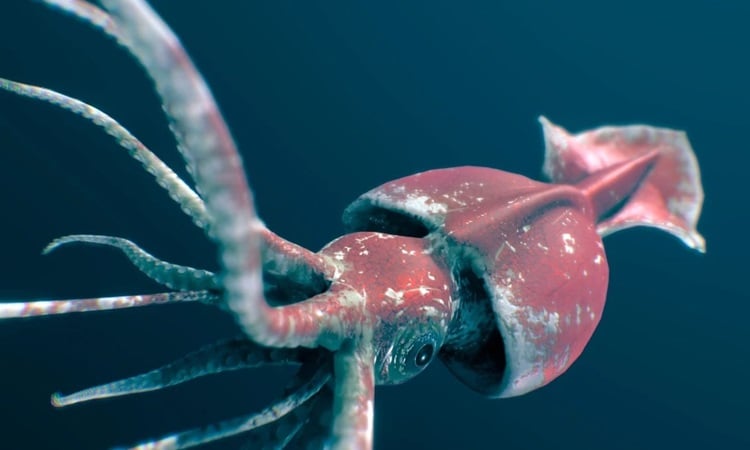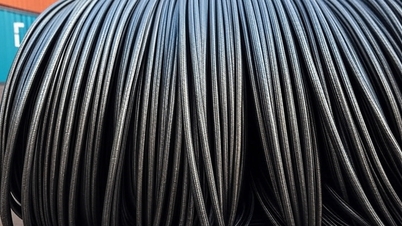Because they live at depths of thousands of meters and rarely surface, the behavior and reproduction of Antarctic giant squid remains a big mystery to researchers.
Simulation of a giant Antarctic squid living in the deep sea. Video : Te Papa Museum
While the giant squid is a monster in size, it has an even larger and more elusive cousin, the Antarctic giant squid. The first evidence of an Antarctic giant squid came from tentacles found in the stomach of a sperm whale in 1925. It wasn't until 1981 that researchers captured the first intact Antarctic giant squid, a sub-adult female. The animal's scientific name, Mesonychoteuthis hamiltoni , comes from its distinctive sharp hooks on its arms and tentacles. In contrast, the giant squid's tentacles have suction cups with small teeth, according to ThoughtCo .
While giant squid can be longer than the Antarctic giant squid, the latter has a longer tunic, a wider body, and a larger mass than its cousin. The Antarctic giant squid measures around 12-14 m in length and weighs up to 750 kg, making it the largest invertebrate on Earth. Its enormous size is also reflected in its eyes and beak. The Antarctic giant squid's beak is the largest of any squid, and its eyes are 30-40 cm in diameter, the largest in the animal kingdom.
Photos of Antarctic giant squid are rare because they live in the deep sea and are not designed to be brought to the surface. Photos show that before being brought to the surface, they have red skin and a bulging mantle. A specimen is on display at Te Papa Museum in Wellington, New Zealand, but does not show the natural color or size of a live squid.
The Antarctic giant squid is found in the cold waters of the Southern Ocean. Its range extends north of Antarctica and south of South Africa, South America and New Zealand. Juvenile squid are found at depths of one kilometer, while adults are found at depths of at least 2.2 kilometers, so the squid's behavior remains a mystery to researchers.
Antarctic giant squid do not eat whales, but instead prey on them. Some sperm whales have scars that appear to be from hooks on the tentacles of Antarctic giant squid, which may be used for defense. When researchers examined the stomach contents of sperm whales, 14% of the squid beaks came from Antarctic giant squid. Other animals that eat them include beaked whales, elephant seals, Patagonian toothfish, albatrosses, and sleeper sharks. However, most of these predators only eat juvenile squid. Adult beaks have only been found in the stomachs of sperm whales and sleeper sharks.
Few scientists or fishermen have ever observed Antarctic giant squid in their natural habitat. Because of their size, depth of habitat, and body shape, researchers believe they are ambush predators, using their large eyes to track passing prey before attacking with their beaks. They have not been seen swimming in schools, so they may be solitary hunters. Scientists have also not witnessed Antarctic giant squid mating and breeding. What they do know is that they are sexually dimorphic. Adult females are larger than males and have ovaries containing thousands of eggs. It is possible that Antarctic giant squid lay their clutches inside the buoyant gel.
Currently, the Antarctic giant squid is listed as “least concern” in terms of conservation. It is not considered endangered, although researchers have not been able to estimate its numbers. Human encounters with the two giant squid species are rare. Neither species can sink ships or attack sailors. They prefer to live at great depths. Adult Antarctic giant squid do not usually come near the surface because warm temperatures affect their buoyancy and reduce the oxygen in their blood.
An Khang (According to IFL Science/ThoughtCo )
Source link



![[Photo] Prime Minister Pham Minh Chinh chairs the Conference to deploy the National Target Program on Drug Prevention and Control until 2030](https://vphoto.vietnam.vn/thumb/1200x675/vietnam/resource/IMAGE/2025/10/09/1759990393779_dsc-0495-jpg.webp)


![[Photo] Impressions of the Can Gio Whale Festival](https://vphoto.vietnam.vn/thumb/1200x675/vietnam/resource/IMAGE/2025/10/09/1759984089762_image12334-5642-jpg.webp)




























































































Comment (0)